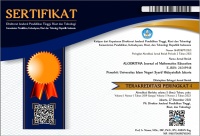ENHANCING STUDENTS’ UNDERSTANDING OF MATHEMATICAL CONCEPTS THROUGH THE CONCRETE-PICTORIAL-ABSTRACT (CPA) APPROACH IN LEARNING FRACTIONS
Abstract
Abstract
Conceptual understanding can be demonstrated by students in restating concepts, classifying objects, presenting concepts, selecting and using procedures, and applying concepts in problem-solving. In reality, students of MTsN 28 Jakarta still struggle to solve everyday problems due to their limited conceptual understanding ability. The purpose of this study was to describe the implementation of the CPA (Concrete-Pictorial-Abstract) approach in mathematics learning, as well as to examine the improvement of students' mathematical concept understanding abilities in fraction material with the CPA approach in class VII-F MTs Negeri 28 Jakarta. This study employs a Classroom Action Research (CAR) design conducted in two cycles. Each cycle consists of stages of planning, implementation, observation, and reflection. The research subjects observed in the study were six students from the upper, middle, and lower groups. Data analysis refers to the evaluation of indicators of conceptual understanding abilities, as observed in the research subject's test answers, which are presented through three stages: data reduction, data presentation, and conclusion. The study's results showed that the average test scores increased from Cycle I to Cycle II. Student learning completeness also increased from the Cycle I and Cycle II tests. Thus, the CPA approach can improve students' ability to understand mathematical concepts.
Abstrak
Pemahaman konseptual dapat ditunjukkan siswa dalam menyatakan ulang konsep, mengklasifikasikan objek-objek, mempresentasikan konsep, memilih dan menggunakan prosedur, dan mengaplikasikan konsep dalam pemecahan masalah. Pada kenyataannya, siswa MTsN 28 Jakarta masih kesulitan dalam memecahkan masalah sehari-hari karena kemampuan pemahaman konseptual mereka yang terbatas. Tujuan dari penelitian ini adalah untuk mendeskripsikan implementasi pendekatan CPA (Concrete-Pictorial-Abstract) dalam pembelajaran matematika, serta mengkaji peningkatan kemampuan pemahaman konsep matematis siswa pada materi pecahan dengan pendekatan CPA di kelas VII-F MTs Negeri 28 Jakarta. Penelitian ini menggunakan desain Penelitian Tindakan Kelas (PTK) yang dilakukan dalam dua siklus. Setiap siklus terdiri dari tahap perencanaan, pelaksanaan, observasi, dan refleksi. Subjek penelitian yang diamati dalam penelitian ini adalah enam orang siswa dari kelompok atas, menengah, dan bawah. Analisis data mengacu pada evaluasi indikator kemampuan pemahaman konsep, sebagaimana diamati pada jawaban tes subjek penelitian, yang disajikan melalui tiga tahap yaitu reduksi data, penyajian data, dan kesimpulan. Hasil penelitian menunjukkan bahwa nilai rata-rata tes meningkat dari Siklus I ke Siklus II. Ketuntasan belajar siswa juga mengalami peningkatan dari tes Siklus I dan Siklus II. Dengan demikian, pendekatan CPA dapat meningkatkan kemampuan siswa dalam memahami konsep matematika.
Keywords
References
Aan Yuliyanto, Turmudi, Mubiar Agustin, I. M., Hafiziani, & Putri, E. (2020). The Relationship of Self Efficacy with Student Mathematics Learning Outcomes Through The Concrete-Pictorial-Abstract (CPA) Approach in Primary Schools. JPSD (Jurnal Pendidikan Sekolah Dasar), Vol. 6 No.
Agustina, D. . (2024). Pendekatan CPA (Concret Pictorial Abstrak) dan Matematika Realistik Bagi Siswa SD. Maghza Pustaka.
Altrichter, H., Kemmis, S., McTaggart, R., & Zuber‐Skerritt, O. (2002). The concept of action research. The Learning Organization, 9(3), 125–131. https://doi.org/10.1108/09696470210428840
Amir, N. F., & Andong, A. (2022). Kesulitan Siswa dalam Memahami Konsep Pecahan. Journal of Elementary Educational Research, 2(1), 1–12. https://doi.org/10.30984/jeer.v2i1.48
Ardila, A., & Hartanto, S. (2017). Analisis Faktor yang Mempengaruhi Rendahnya Motivasi Belajar Siswa Pada Mata Pelajaran Matematik. PYTHAGORAS: Jurnal Program Studi Pendidikan Matematika, 6(2), 175–186.
Asfara, F., Fitri, H., Rusdi, R., & Aniswita, A. (2022). Pengaruh Pendekatan Concrete–Pictorial–Abstract (CPA) Terhadap Kemampuan Pemahaman Konsep Matematis Siswa Kelas Vii Smp Negeri 1 Ujungbatu Provinsi Riau. Jurnal Pendidikan Dan Konseling (Jpdk), 4(5), 5567-5573.
Chang, S. H., Lee, N. H., & Koay, P. L. (2017). Teaching and learning with concrete-pictorial-abstract sequence: A proposed model. The Mathematics Educator, 17(1), 1–28.
Findell, B., Swafford, J., & Kilpatrick, J. (2001). Adding it up: Helping children learn mathematics. National Academies Press.
Flores, M. M. (2010). Using the Concrete-Representational-Abstract Sequence to Teach Subtraction With Regrouping to Students at Risk for Failure. Remedial and Special Education, 31(3), 195–207. https://doi.org/10.1177/0741932508327467
Hinton, V. M., & Flores, M. M. (2019). The Effects of the Concrete-Representational-Abstract Sequence for Students at Risk for Mathematics Failure. Journal of Behavioral Education, 28(4), 493–516. https://doi.org/10.1007/s10864-018-09316-3
Hoong, L. Y., Kin, H. W., & Pien, C. L. (2015). Concrete-Pictorial-Abstract: Surveying its Origins and Charting its Future. The Mathematics Educator, 16(1), 1–18. http://math.nie.edu.sg/ame/matheduc/tme/tmeV16_1/TME16_1.pdf
Irfan, M., Slamet Setiana, D., Fitria Ningsih, E., Kusumaningtyas, W., & Adi Widodo, S. (2019). Traditional ceremony ki ageng wonolelo as mathematics learning media. Journal of Physics: Conference Series, 1175(1). https://doi.org/10.1088/1742-6596/1175/1/012140
Miles, M. B., Huberman, A. M., & Saldaña, J. (2014). Qualitative Data Analysis: A Methods Sourcebook (3rd ed.). Sage.
Novianto, A., Fitriani, N., Deniswa, A. S., Izzati, M. H., Firdaus, F., Ningrum, N., & Dewi, R. C. (2024). Analisis Kesulitan Belajar Matematika dalam Penerapan Kurikulum Merdeka di Sekolah Dasar. Jurnal Ilmiah Kependidikan, 12(2), 946–960.
Piaget. (1976). Piaget’s theory. Springer.
Purwadi, I. M. A., Sudiarta, I. G. P., & Suparta, I. N. (2019). The effect of concrete-pictorial-abstract strategy toward students’ mathematical conceptual understanding and mathematical representation on fractions. International Journal of Instruction, 12(1), 1113–1126. https://doi.org/10.29333/iji.2019.12171a
Puspitarini, Y. D., & Hanif, M. (2019). Using Learning Media to Increase Learning Motivation in Elementary School. Anatolian Journal of Education, 4(2), 53–60. https://doi.org/10.29333/aje.2019.426a
Putri, H. E., Misnarti, M., & Saptini, R. D. (2018). Influence of Concrete-Pictorial-Abstract (Cpa) Approach Towards the Enhancement of Mathematical Connection Ability of Elementary School Students. EduHumaniora | Jurnal Pendidikan Dasar Kampus Cibiru, 10(2), 61. https://doi.org/10.17509/eh.v10i2.10915
Rittle-Johnson, B., Schneider, M., & Star, J. R. (2015). Not a One-Way Street: Bidirectional Relations Between Procedural and Conceptual Knowledge of Mathematics. Educational Psychology Review, 27(4), 587–597. https://doi.org/10.1007/s10648-015-9302-x
Rohmah, M., & Sutiarso, S. (2018). Analysis problem solving in mathematical using theory Newman. Eurasia Journal of Mathematics, Science and Technology Education, 14(2), 671–681. https://doi.org/10.12973/ejmste/80630
Suryaningsih, T. (2025). Journal of Integrated Elementary Education Enhancing Elementary Students ’ Numeracy Skills Through The Concrete Pictorial Abstract ( CPA ) Approach. 5(1), 224–236.
Widodo, S. A., & Wahyudin. (2018). Selection of Learning Media Mathematics for Junior School Students. Turkish Online Journal of Educational Technology - TOJET, 17(1), 154–160.
Zulkarnain, I., & Budiman, H. (2019). Pengaruh pemahaman konsep terhadap kemampuan pemecahan masalah matematika. Research and Development Journal of Education, 6(!), 18–27.
DOI: 10.15408/ajme.v7i1.47153
Refbacks
- There are currently no refbacks.












